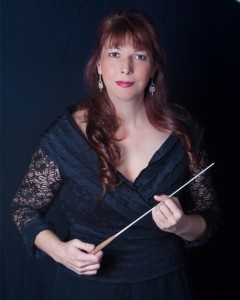Mostly Masonic Mozart in an apt setting from Orchestra Miami
Two seasons ago Orchestra Miami presented an all-Mozart program in the ornate auditorium of the Scottish Rite Temple. On Sunday afternoon Elaine Rinaldi and her ensemble returned to that landmark edifice on the outskirts of downtown Miami for a concert that was designated as “More Masonic Mozart.”
Two of the works on the program definitely had strong Masonic connotations. (Mozart was an active freemason.) Rinaldi’s assertion that a Mozart symphony and piano concerto were Masonic-related scores was more dubious. Still the afternoon’s fare offered a fine cross-section of the Salzburg master’s output. The performances, however, were uneven.
The concert opener was the Interlude No. 2 from Thamos, King of Egypt, a Masonic drama with a libretto similar in many aspects to that of The Magic Flute. Some of the area’s strongest freelance players populated the ensemble’s ranks. Even so, while Rinaldi shaped the repetitive principal theme adroitly and the playing was accurate, the orchestra’s sonority was on the thin side.
Paul Posnak, recently retired from the faculty of the University of Miami’s Frost School of Music, was a nimble soloist in Mozart’s Piano Concerto No. 20 in D minor. Playing a bright-toned Yamaha, Posnak took a vigorous approach to the opening movement. His dynamics were nicely varied within a classical framework, avoiding overt bombast. Posnak’s own bravura cadenza had more than a touch of the Beethoven that was to come.
The Romance was gracefully shaped and Posnak stylishly accentuated the ornamented repetitions of the main melody. A fleet Rondo finale demonstrated Posnak’s agile technique with the contrasting second subject nicely turned.
The orchestra accompaniment was not on the same level. Repeated intonation problems plagued the orchestral introduction and the ensemble’s corporate sound was undernourished. There were moments, particularly in the outer movements, when Rinaldi’s pedantic tempos and shaping were not in sync with Posnak’s crisp phrasing. The dialogues between piano and winds, however, were well delineated.
After intermission it seemed like a different conductor and orchestra had taken the stage. The Masonic Funeral Music was given a powerful sense of mourning from the initial bars. Rinaldi gradually built volume and depth of emotion to a strong but properly restrained climax. The strings under concertmaster Gennady Aronin played with strength and full tone and there was fine solo work by clarinetist Richard Hancock and oboist Erika Yamada.
The Symphony No. 39 in E-flat Major is the first of Mozart’s final trio of masterpieces in that orchestral genre. Rinaldi and her forces offered a sunny reading that was not lacking in weight or heft. The Adagio introduction had solemn nobility with the ensuing Allegro sprightly and vigorous in contrast. Mozart’s wonderful modulations between major and minor were clearly articulated and well pointed.
String tone was silky in the Andante con moto and Rinaldi paced the melodies spaciously without undue heaviness. The Menuetto was taut and robust. That carried over into the high-spirited finale. With Rinaldi’s stronger direction and the players’ solid execution, the symphony received the afternoon’s strongest performance.
Posted in Performances
One Response to “Mostly Masonic Mozart in an apt setting from Orchestra Miami”
Leave a Comment
Tue Apr 19, 2016
at 11:05 am
1 Comment








Posted Jun 15, 2016 at 8:35 pm by P. Frank
Was I at the same performance as the reviewer? He’s spot on about the high quality of the second half, but orchestra and conductor were equally as apt in the first half. Perhaps he wasn’t that familiar with some of the lesser known works.